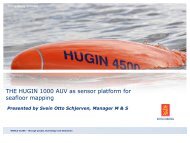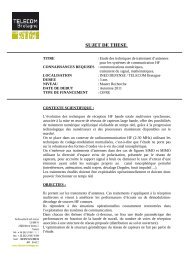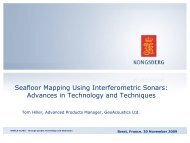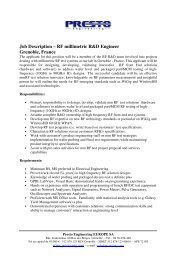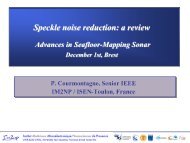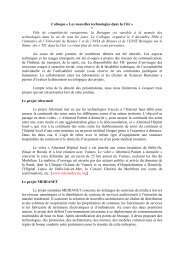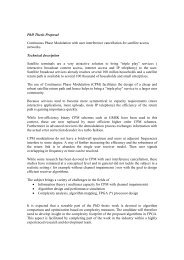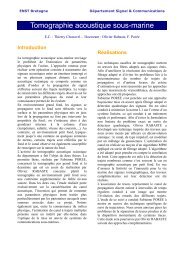Département Réseau, Sécurité et Multimédia Rapport d'Activités 2008
Département Réseau, Sécurité et Multimédia Rapport d'Activités 2008
Département Réseau, Sécurité et Multimédia Rapport d'Activités 2008
Create successful ePaper yourself
Turn your PDF publications into a flip-book with our unique Google optimized e-Paper software.
Adaptive Application Support in Mobile N<strong>et</strong>worksResearch Staff : Jean-Marie Bonnin, Nicolas Montavont, Namhoon Kim, Mathieu PeressePh.D. Student: Rayène Ben RayanaKeywords : ambient n<strong>et</strong>works, n<strong>et</strong>work mobility, h<strong>et</strong>erogeneous access n<strong>et</strong>works, IPv6, adaptativeapplicationsApplications : ITS, entertainmentPartners & Funding : TELECOM Br<strong>et</strong>agne (RSM), France Telecom R&D (project leader), ThalesCommunications, ARTAL, ULP (LSIIT) partially funded by ANR.IntroductionThe number of devices that rely on theIntern<strong>et</strong> in order to provide the service usersexpect continue to growth in an astonishingrate. Unfortunately, as these services are usedwhile traveling each device has to manage themobility on its own. This is not efficient:• in terms of power consumption since eachdevice has to reach a base station or anaccess point;• in terms of n<strong>et</strong>work burden, since thenumber of mobility events the n<strong>et</strong>work hasto manage increase with the number ofmobile terminals;• in terms of deployment complexity sinceeach mobile device has to manage themobility and then, has to be configuredthrough an interface. Or simplest devicesuch as sensor could use some autoconfigurationmechanisms.In order to solve these problems, IETF hasdesigned a protocol call NEMO Basic Support.This protocol free mobile terminal of mobilitymanagement introducing a Mobile Router thatwill provide Intern<strong>et</strong> connectivity to allequipments embarked in the mobile n<strong>et</strong>work.It will manage transparently mobility events,taking in charge the tunnel s<strong>et</strong>up and tierdown,the signaling with the Home Agent andthe routing stuff. Embarked terminals will onlyhave to manage their Intern<strong>et</strong> connectivity inthe same way they would do in a LAN.The REMORA ANR-RNRT project aims atdeveloping technical solutions for compl<strong>et</strong>emanagement of the whole n<strong>et</strong>work mobility s<strong>et</strong>of issues. The new capabilities implementedinside REMORA shall enable clevermanagement of mobile n<strong>et</strong>works and of theirinterconnection with multiple access n<strong>et</strong>works.Technical approachThe n<strong>et</strong>work mobility mechanism is based onthe solution defined by the NEMO workinggroup at the IETF. Extension related tomultiple access management (MCoA: MultipleCare-of Address) and routing policies exchangehave been integrated in the core architecture.The project specifically considers the followingaspects:• mobility management on a flow-by-flowbasis while improving reliability of thewhole architecture. These capabilities willallow permanent access to the Intern<strong>et</strong> fordevices with reduced functionalities.mobilen<strong>et</strong>workmobilerouter• providing adaptive applications running onnested devices with connectivityinformation in order to allow them toadapt.• making application able to declare theirneeds to the mobile router, which takes64 Pracom’s Annual Report <strong>2008</strong>



